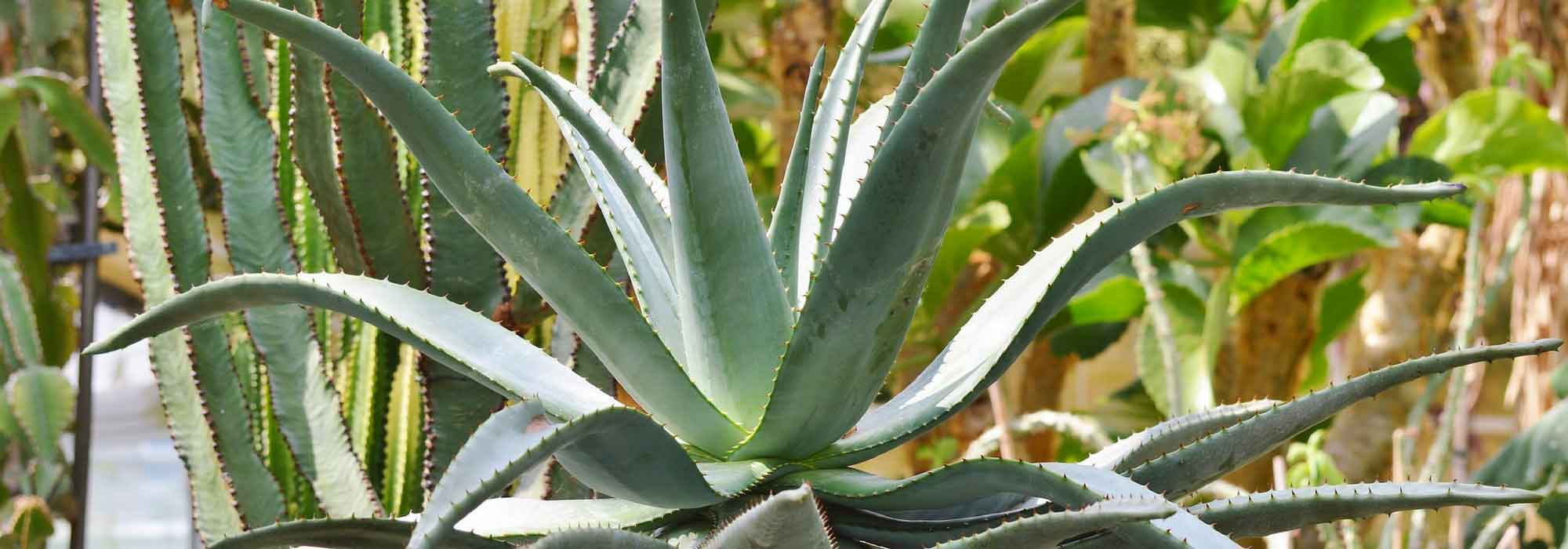
Agave: planting, growing, and caring for
Contents
Agave in a nutshell
- Agave is a succulent with broad, graphic foliage
- Easy to grow in full sun and well-drained soil, it is the plant to grow in arid climate
- With exemplary undemanding nature, agave can go without watering for several weeks
- Semi-hardy, it is a preferred perennial for the Mediterranean and Atlantic regions
- It is an excellent plant for rockeries and gravel beds
A word from our expert
Agave is a superb succulent of arid climate, thriving in sunny, well-drained, poor soils where it can be hardy down to around -10°C. It has now become an integral part of the landscape in the South of France.
Mexican Agave is used to produce agave syrup, a highly valued natural sugar in cooking.
The beauty of the flowering Agave is matched only by its rarity! Living for several decades before producing an impressive flowering display, this perennial with its unique graphic form continues to attract collectors!
While the giant Agave americana with its imposing silhouette is the most well-known, others like Agave attenuata, blue Agave (Agave tequilana), and Agave parryi are also beautiful and sometimes even more cold-resistant.
With its truly exotic temperament, Agave is perfect for adding an original touch in gardens spared from severe frosts or on a south-facing terrace elsewhere.
It is undoubtedly the centrepiece for a large exotic rockery, a gravel bed, or a sun-baked slope.
Quickly complete your collection by discovering our Agaves, these low-maintenance plants that are easy to grow in mild climates, creating a clean, mineral, and remarkably exotic decor.
Description and Botany
Botanical data
- Latin name Agave
- Family Agavaceae
- Common name Agave
- Flowering July to August
- Height 0.45 to 4 m
- Exposure Sun
- Soil type poor, well-drained
- Hardiness -5°C to -23°C
The Agave is a succulent plant native to the rocky desert and mountainous regions of Mexico, the southern United States, and the Caribbean. It belongs to the Agavaceae family, alongside Yuccas and the Tuberose.
The genus includes over 200 species, the most common in our gardens in southern France being the Agave americana, a giant, which has naturalised in many parts of the world today. It is complemented by numerous species and varieties obtained through cross-breeding: the less spiny Agave attenuata with its “swan neck” inflorescence, Agave filifera with filamentous foliage, A. ferox and Agave havardiana edged with fierce thorns, Agave victoriae reginae, well-known for its rosettes of leaves edged in white, or the blue agave from Mexico (A. tequilana), which, as its name suggests, is used in the production of “tequila”.
The Agave grows rather slowly but has a beautiful longevity of 10 to 30 years. Its development is more or less moderate depending on the species, ranging from 15 cm for Agave parviflora to 3 m in height and spread at maturity for the monumental A. americana.
The habit is more or less regular and compact, perfectly round, with a geometric shape (Agave victoriae reginae), in an upright cup shape or more unruly with slightly incurved leaves.
Over the years, the bush thickens thanks to its rhizomes capable of producing offsets all around the initial rosette to ensure its longevity. It can become invasive where it thrives.
This succulent plant differs mainly in the number of leaves that make up its rosette.
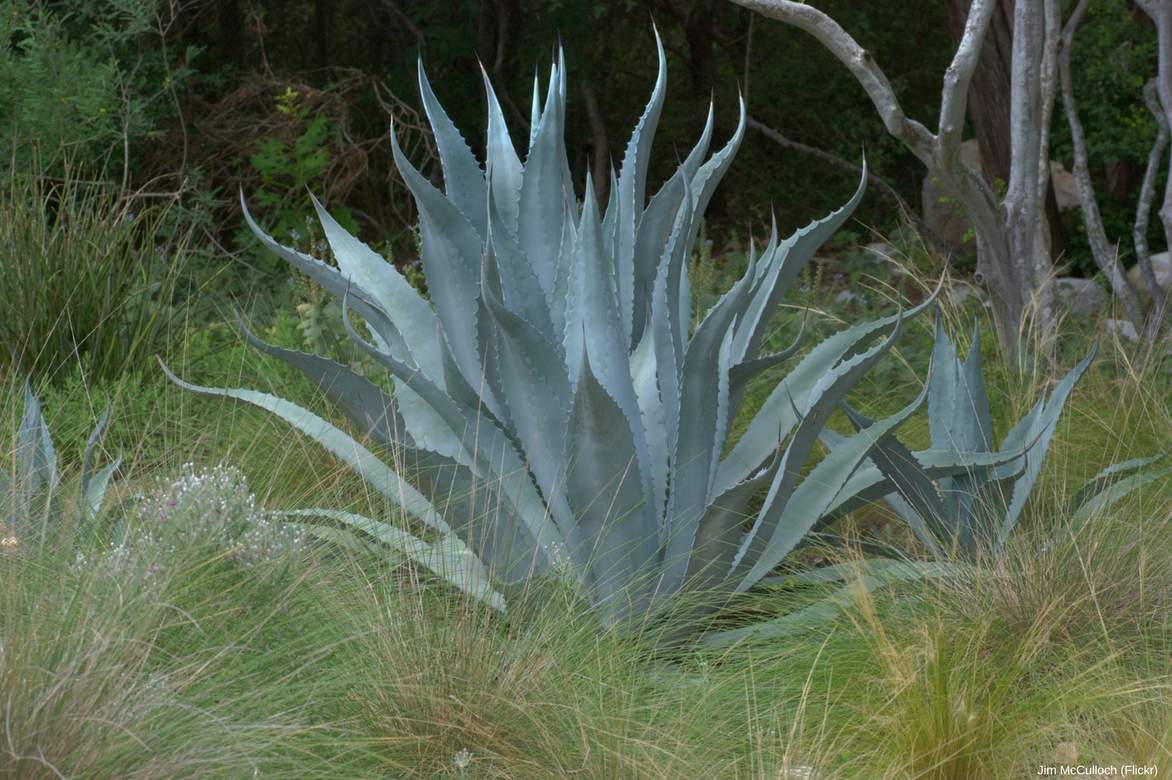
The rigid silhouette of the Agave americana balanced by the lightness of grasses.
This impressive perennial is highly valued for its often monumental silhouette and always remarkably graphic appearance. The Agave develops like a large artichoke or flower bud, in a dense and radiant rosette, more or less open.
It is composed of very numerous fleshy leaves, very wide at the base, thick and leathery, resting directly on the ground, imbricate with one another. Only certain species like Agave attenuata flourish around a thick, branched trunk bearing rosettes.
The leaves, 15 to 2.5 m long, flat, slightly bulging, are stiff, tapered, or paddle-shaped, more or less ovate and narrowed at the tip. They are often dentate with sharp thorns regularly spaced, true hooked teeth, in black, orange-copper to reddish hues, which should be approached with caution. They leave sinuous imprints in the waxy epidermis of neighbouring leaves.
The tips of the leaves are sometimes equipped with a spiny point of the same colour. The foliage of Agave filifera, devoid of thorns, is edged with long white filaments.
Dark green to yellowish-green, light green edged in white in the Queen Victoria Agave, grey-green, blue-green edged in cream-yellow in Agave americana ‘Variegata’, grey-green with a bluish tint marked by a central white band in the Mexican Agave ‘Alba’, they take on all shades of green, grey, and blue or offer graphic variegations. They are often covered with a whitish bloom.
Flowering, always impressive in large agaves, only occurs once the plant has reached maturity, after 10 to 40 years of cultivation. It is quite rare to see it bloom in France. This flowering signals the death of the plant. In summer, majestic floral spikes, reaching up to 10 m in height in Agave americana, arise from the heart of the rosettes.
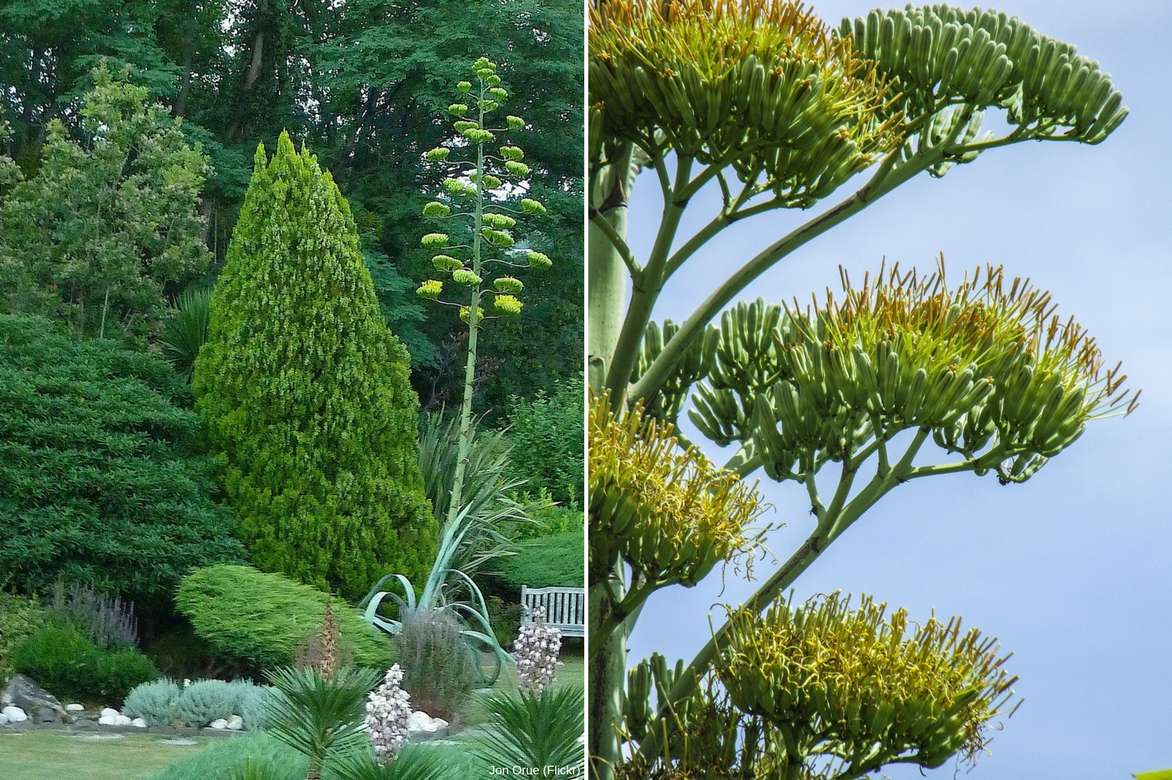
The spectacular flowering of the Agave americana.
They consist of a myriad of small tubular flowers in yellow-green, silver-yellow or white-green, sometimes red, each with six tepals, gathered in umbels, clusters, or panicles. Very melliferous and nectariferous, they attract many foraging insects.
The inflorescences then give way to fruits, whose seeds will scatter on the ground, as well as bulbils that will root once the rosette has collapsed, provided your Agave flowers and forms them.
This flowering, as spectacular as it is unique, exhausts the rosette that gave birth to it, but generates the birth of a new offset. Most agaves only flower once before dying as they are monocarpic plants: the rosettes die after flowering and fruiting, in favour of numerous small peripheral rosettes that will thicken and flower in turn in the following years, thus ensuring their offspring.
The Agave is a rather frost-sensitive plant, easy to cultivate in regions with very mild winters, in full sun, in a preferably poor, even stony, calcareous, sandy soil. Hardy down to about -12°C (the Agave havardiana can withstand frosts of around -23°C), in perfectly drained soil, in colder regions, it should be grown in large pots to be sheltered in winter.
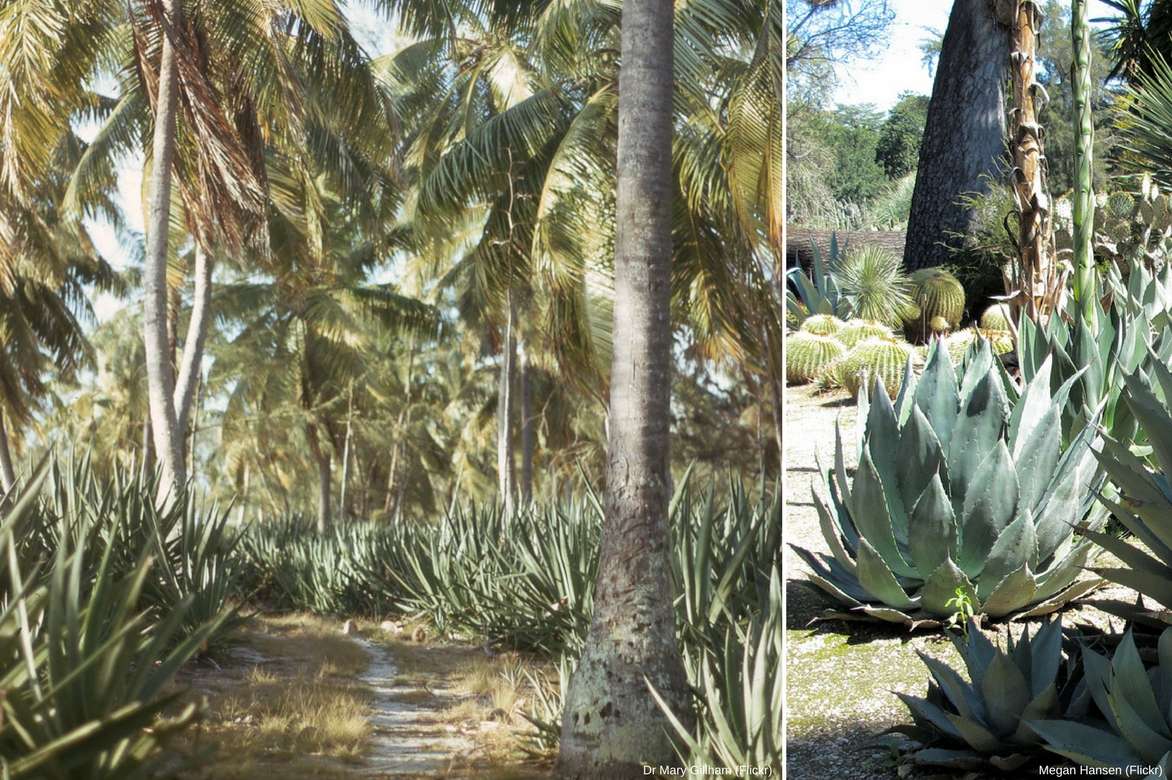
From left to right: Pathway lined with Agave americana under palm cover – Agave havardiana accompanied by cacti.
In a mild climate where frost is very rare, it will find its place in a large exotic rockery, a dry bank, or in a raised wild bed.
The Mexican Agave is also used to make alcoholic beverages such as mezcal, and tequila made from the flower buds of A. tequilana, or agave syrup which can replace sugar in cooking.
“`
Main species and varieties
The genus Agavaceae includes nearly 200 species and cultivars so varied that they allow for a beautiful collection to be established quickly! Generally moderately hardy, some species of Agave stand out and can be grown in most of our regions.
The large Agave americana withstands high temperatures as well as cold down to -10°C. The Agave havardiana is one of the hardiest in the genus and tolerates dry spells of around -20°C.
→ Discover the hardiest Agaves
Some are thorny, others are filamentous; they can be bluish, variegated with yellow or white, giant (3 m wide at ripeness) or smaller (Agave potatorum), well-suited for pot cultivation.
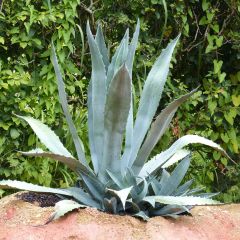
Agave americana
- Flowering time August, September
- Height at maturity 1,50 m
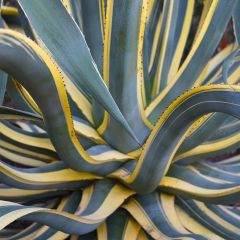
Agave americana Variegata - American Agave
- Flowering time August, September
- Height at maturity 1,50 m

Agave havardiana
- Flowering time August, September
- Height at maturity 50 cm
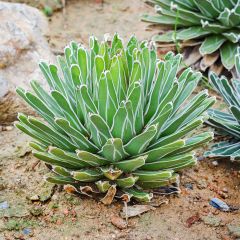
Agave victoriae reginae - Queen Victorias Agave
- Flowering time August, September
- Height at maturity 50 cm
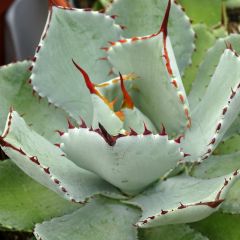
Agave Kichijokan
- Flowering time August, September
- Height at maturity 40 cm
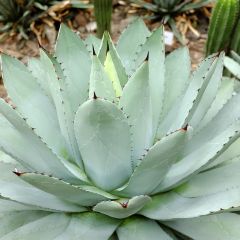
Agave potatorum var. verschaffeltii
- Flowering time August, September
- Height at maturity 60 cm
Discover other Agave
View all →Available in 2 sizes
Available in 1 sizes
Available in 1 sizes
Available in 2 sizes
Available in 2 sizes
Available in 2 sizes
Available in 0 sizes
Available in 1 sizes
Available in 1 sizes
Available in 1 sizes
Planting
Where to Plant Agave
Agave is perfectly suited to dry, hot climates and poor soils. It is a rather tender perennial that will withstand light frosts of short duration down to about -12°C (sometimes even lower for certain agaves) but only in open ground in the south of France, in poor, very well-drained soil. The drier the soil, the more frost-resistant it will be. Elsewhere, its hardiness is often put to the test.
Agave loves heat, sunshine, and arid soils, similar to “cactus soil.” It is very drought-resistant and can endure very high temperatures. In favoured regions, plant Agave in full sun in a well-sheltered spot, preferably on a well-sloped and well-drained site where water never stagnates.
While this beautiful succulent perennial proves to be quite hardy in dry soil, it does not tolerate excess moisture well, especially in winter, which would surely cause it to rot. It also struggles with winter rains and heavy, waterlogged soils in winter.
In mild climates, it copes well with sea spray.
Provide it with a location that matches its substantial growth: after a few years, Agave can become exuberant in open ground and for the larger varieties, reach surprising dimensions of up to 4-5 metres in diameter and the same in height!
Give it a clear space and keep spiny agaves away from pathways and young children!
In regions with harsh winters, it should be grown in a very large pot well sheltered on the terrace, to be brought indoors in winter or into a cold greenhouse, protected from severe frosts.
With its imposing and remarkably graphic stature, this succulent plant structures the exotic and wild decor of large dry rockeries, south-facing slopes, and large gravel beds, adding depth to the landscape.
In pots, it gives a striking exotic flair to terraces and small urban gardens. Among a collection of cacti, it recreates a desert-inspired setting.
When to Plant Agaves
The planting of an agave is best done in spring from April to May or late summer, from August to September.
How to Plant an Agave
If your soil retains moisture, do not hesitate to plant your Agave on a slope that will be naturally drained. Choose a very sunny, warm, and sheltered spot. Pay attention to spacing to ensure its full development: space the plants at least 40 cm apart for smaller species and at least 3 metres for larger Agave species.
- Dig a deep hole (50 cm and even 80 cm for large agaves)
- Add large stones or gravel to a depth of 20 cm at the bottom of the planting hole
- Mix river sand or pumice with half of the extracted soil
- Plant the agave without burying the collar too deeply and fill the hole with this same mixture
- Lightly compact the soil with your foot
- Spread a layer of gravel or pebbles at the base of the plant to keep it dry and prevent rot; it will store daytime heat to release during the night
- Water generously, then suspend watering for 2 to 3 weeks after planting to help it settle in quickly
- After that, water very sparingly and only in very dry weather, allowing the substrate to dry out between waterings
Planting Agave in a Pot
The substrate must be very well-draining to avoid stagnant moisture and root rot. Place it in full sun, in a well-sheltered location. A soil that is too clayey will be detrimental to the hardiness of this undemanding plant: improve drainage with gravel, clay balls, large pebbles, or a mix of stones…
- In a very large terracotta pot (better aeration) of at least 60 cm in diameter, spread a good layer of drainage (gravel or clay balls)
- Plant your agave in a mix of 50 % potting soil and 50 % clay balls or pumice
- Surround the base with a good layer of gravel or pebbles to prevent rot at the collar
- Water at planting, then once a month or even every 15 days during the hottest months. Always allow the soil to dry out between waterings.
- Apply a fertiliser low in nitrogen 3 to 4 times during the summer period
- Once the risk of frost has passed, gradually place the pot in the sun if it has been stored for winter to prevent the foliage from burning irreparably
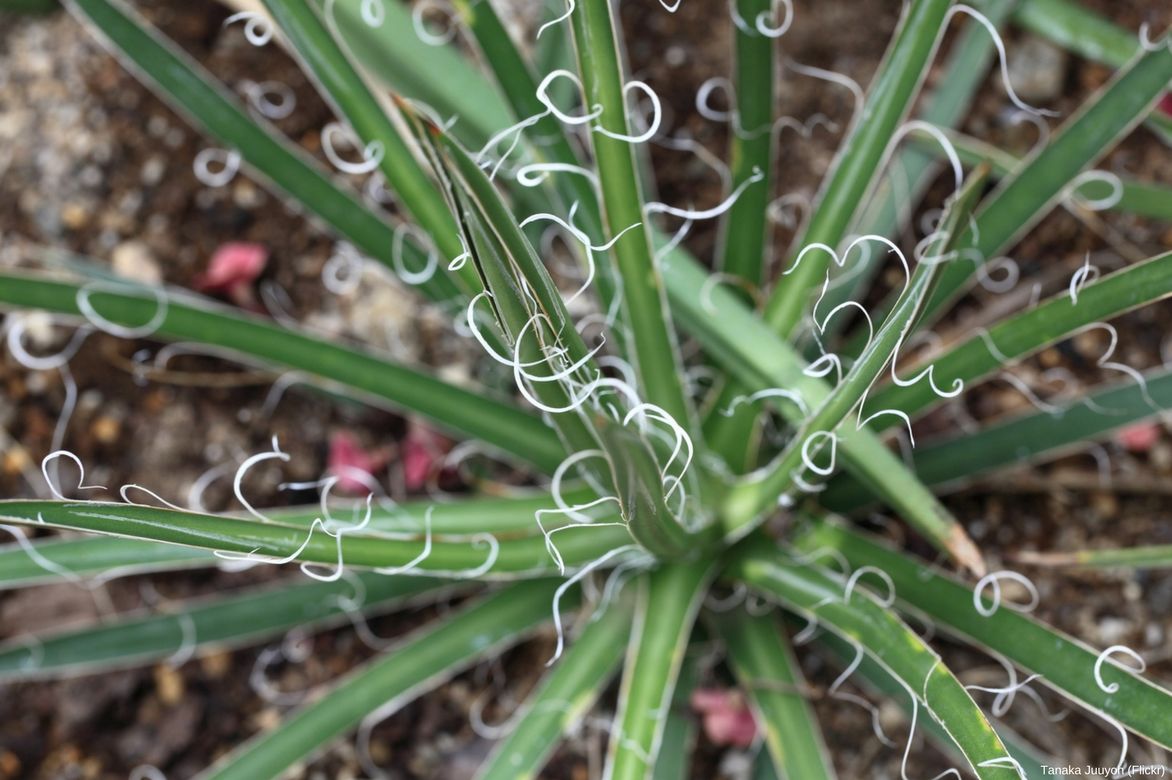
The Agave filifera is adorned with long white filaments.
Read also
Combining AgaveMaintenance and Care
Once well established, Agave requires no special care. It is easy to grow in regions where it does not freeze severely.
In the ground
Protect the base with a thick mineral mulch of gravel. It is a low water consumer as it has the ability to store water and therefore requires little watering.
In summer: water once every 15 days, not more. Once established in well-draining soil, it will become increasingly resistant to drought and will only need watering in case of prolonged dry spells.
Always allow the soil to dry completely between waterings. In winter, stop watering; it relies on rainwater.
In winter, in very wet regions, you can protect the plant from winter rains with a clear plastic sheet raised above the plant.
Pruning is not necessary. Maintenance consists of a simple spring clean-up. In March, wearing thick gloves, clean the old foliage, using pruning shears or shears to cut back any blackened, damaged, or wilted leaves.
In a pot
During summer, feed the plant with a low-nitrogen liquid fertiliser “special for cacti” diluted in the watering water.
Bring the pot indoors before the first frosts, keeping it safe from the cold in a very bright, unheated room (between 0 and -5°C). Potted agaves are more sensitive to cold.
In winter, keep dry.
→ Learn more with Virginie’s tips on wintering an agave
Diseases and potential pests
Installed in well-drained soil and kept warm, the Agave shows a good resistance to diseases. It truly fears only two things: excess water and negative temperatures.
However, young shoots may suffer from attacks by mealybugs, identifiable by the cottony masses they leave on the leaves. They slow down growth and discolour the foliage. Remove the unwanted pests with a cotton pad soaked in 90°C alcohol, then treat with rapeseed oil sprays. Repeat two or three times at 15-day intervals.
If black spots appear on the leaves, it is likely due to excessive humidity: cut the leaves back to the base. Most Agaves are hardier than one might think. Cold itself is not really a problem, down to -7°C. They are more concerned about winter humidity. Excess water in the soil promotes the appearance of fungal diseases leading to root rot.
→ Read also: Agave Weevil: Effective Identification, Treatment, and Prevention.
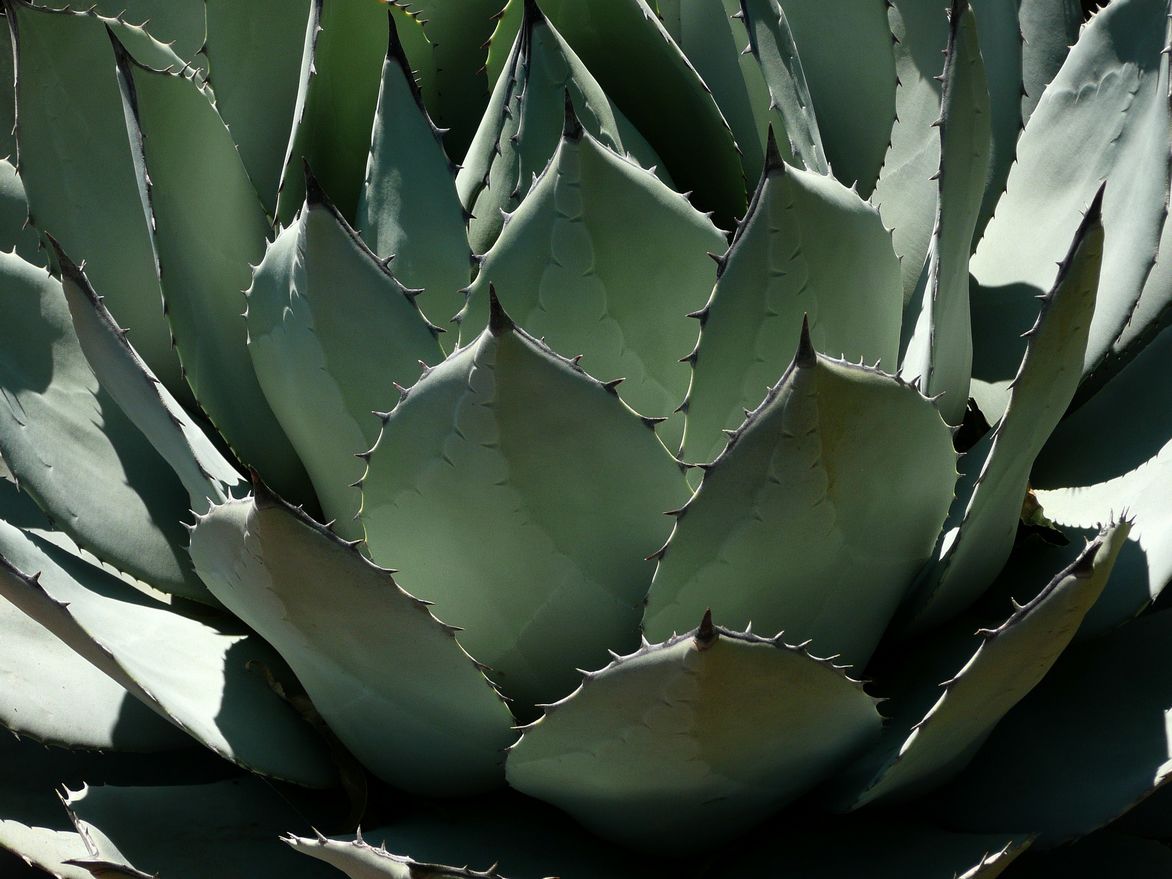
The leaves of the Agave parryi ‘Huachucensis’ are beautifully blue and edged with thorns.
Multiplication
If sowing is possible in February-March, it is very easy to propagate by taking young suckers at the same time. Most agaves naturally produce suckers around the rosette. It is very easy to detach them to propagate the plant from well-developed suckers (if they become too numerous, read about it Invasive agaves: practical guide to getting rid of them).
By dividing the suckers
- Using a spade, gently lift the sucker
- With pruning shears, separate the small agave from the mother plant
- Allow the sucker to dry for a few days in the sun
- Transplant it if it is sturdy enough or pot it on a bed of gravel in a mixture of turf and river sand
- Spread a layer of sand on the surface
- Place the pot in a sheltered location
- Do not water for 15 days to allow small roots to form quickly
- Repot into a larger pot and plant in the ground the following spring
Associate
Agave, whether small or gigantic, is always an important focal point in a garden or in a pot on a terrace.
An undisputed star of dry and wild gardens scorched by the sun, it helps to structure very minimalist exotic scenes, inspired by deserts.
It always brings character and grandeur to a decor.
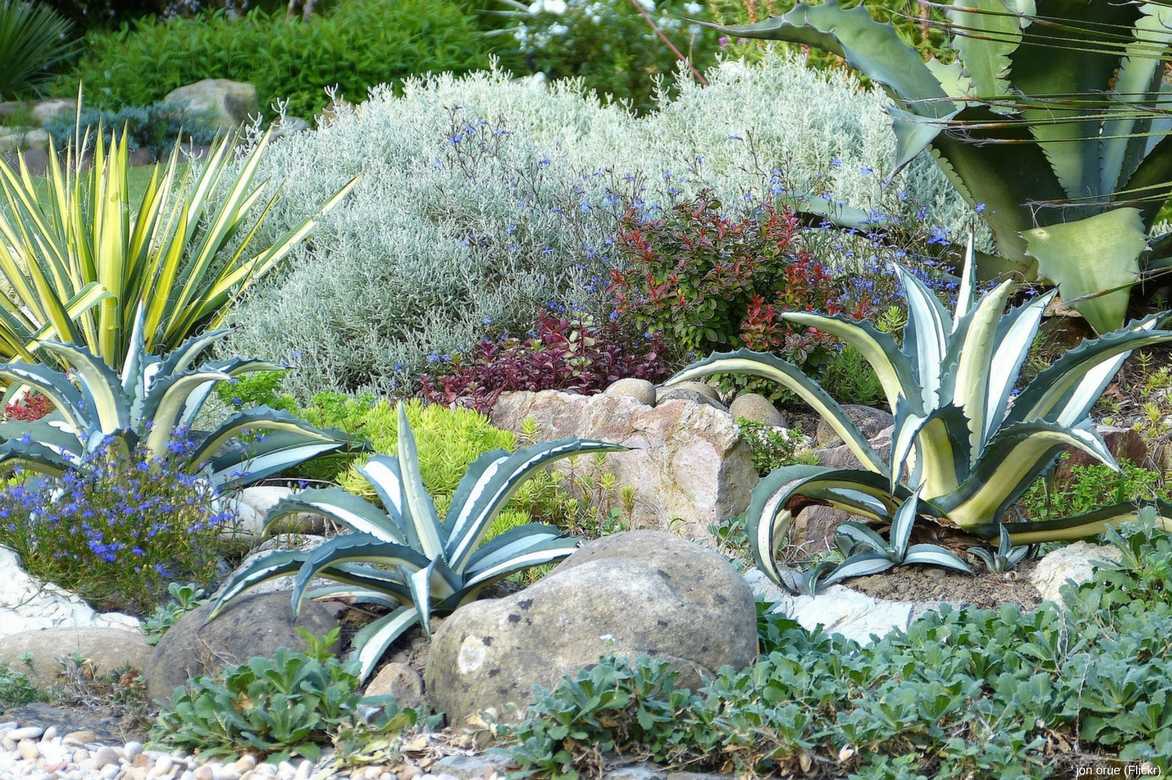
A beautiful example of pairing in a rockery: Agave americana ‘Mediopicta Alba’, Agave montana, Yucca filamentosa ‘Color Guard’, Santolina chamaecyparissus, Berberis thunbergii ‘Admiration’, Lithodora diffusa ‘Heavenly Blue’, Saxifraga urbium, Linum perenne, Sedum reflexum ‘Angelina’, Sedum ‘Bertram Anderson’.
With their architectural habit, large agaves (A. americana) are perfectly suited to create a spectacular centrepiece in a bed of Mediterranean perennials such as Giant Fennel, Hesperaloe parviflora, the Canary Viper’s Bugloss (biennial), or even a Romneya coulteri or Tree Poppy of gigantic proportions. Do be cautious of the shade cast by larger perennials; it needs full sun!
In the ground, in a mild climate, agave will find its place in a large rockery alongside equally undemanding plants like the Barbary Fig (Opuntia ficus-indica) and other prickly pears, such as Cylindropuntia imbricata and Opuntia humifosa, two hardy cacti or Aloe Vera.
For a purely exotic tableau, choose other plants that can withstand frosts down to -10°C; Crassulas, Cordylines, or even Palms.
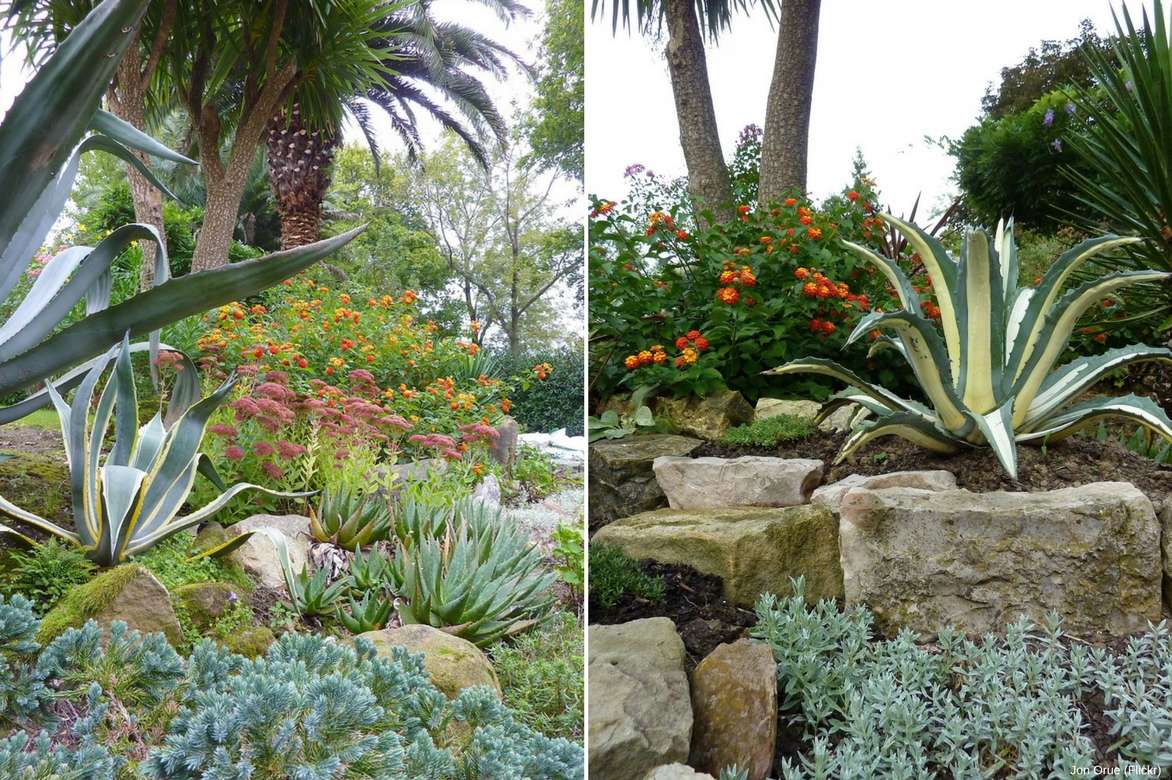
An example of an exotic pairing: Agave americana, Agave americana ‘Variegata’, Aloe nobilis, Lantana camara ‘Lucky Red Flame’, Sedum ‘Herbsfreude’, Juniperus squamata ‘Blue Carpet’, Cordyline australis.
Its graphic silhouette will stand out in mineral scenes, punctuated by some grasses like Miscanthus or Stipa gigantea.
Surround the base of the agaves with groundcover plants for dry soil such as Osteospermum or Cape daisies, dwarf wormwoods, toothworts, perennial purslane, thymes, and sedums.
In a shrub bed, it pairs well with Fremontodendron californicum, a sarmentous shrub with sunny blooms, Australian Rosemary, or a creeping Ceanothus thyrsiflorus.
→ Discover more beautiful pairing ideas with agave
Useful resources
- Are there cacti in the North of France?
- Discover the agaves to collect on our site
- An agave in the ground, it’s possible!
- Our advice sheet: Associating agave
- Our advice sheet: Choosing an agave
- Our advice sheet: Growing an agave in a pot
- Our advice sheet: Wintering an agave
- Our advice sheet: Agave the hardiest varieties
- Our advice sheet: Agaves, the most beautiful varieties
- Our advice sheet: Designing a lush exotic garden and designing a dry exotic garden
- Invite agaves, yuccas, and cacti into your garden!
- Subscribe!
- Contents
































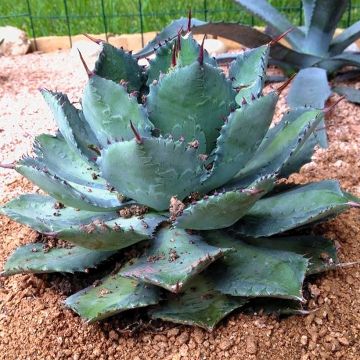
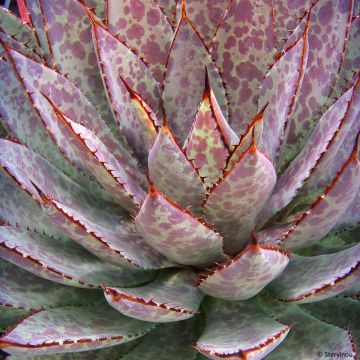
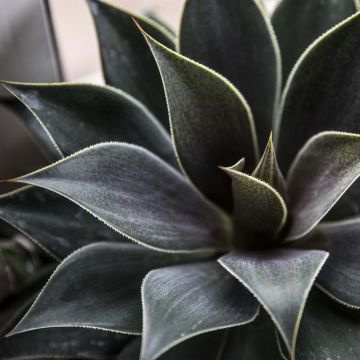

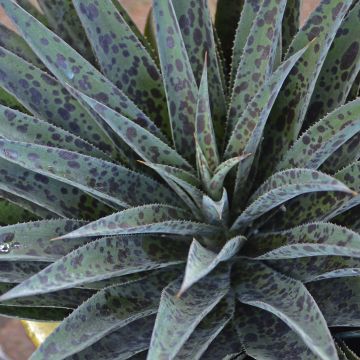
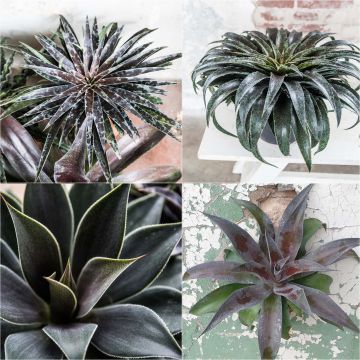

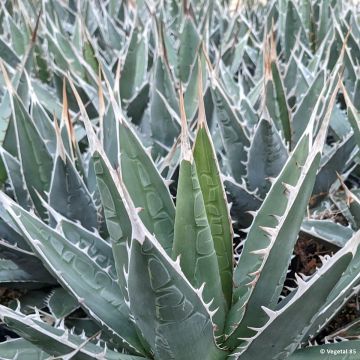
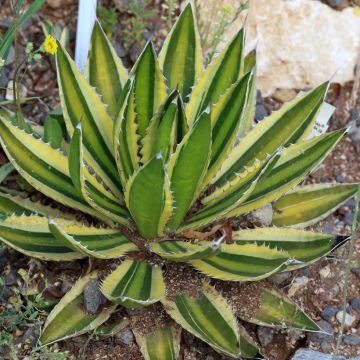
Comments